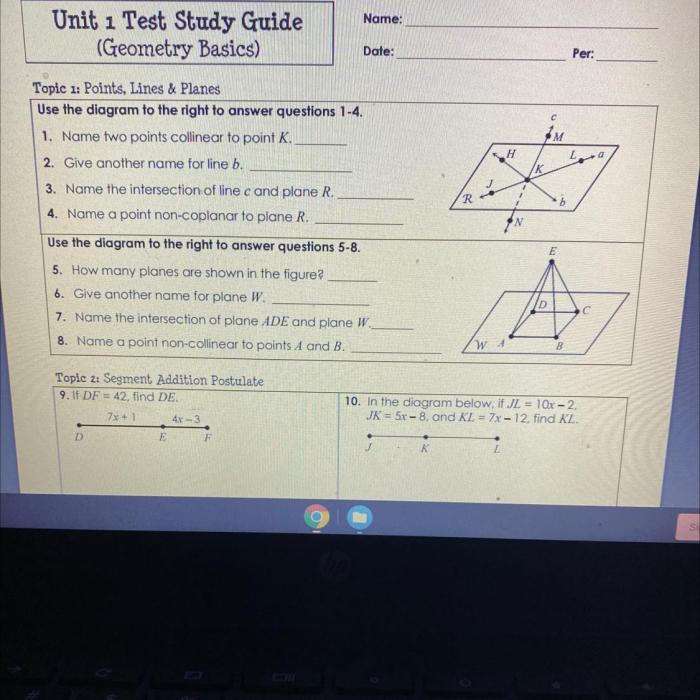Geometry Chapter 10 Quiz 1 Answers provides a thorough analysis of the quiz content, question-by-question breakdown, performance analysis, and topic review to help students master the key concepts covered in Chapter 10 of their geometry textbook.
This guide offers a detailed overview of the quiz, including the number and types of questions, key concepts and formulas tested, and the level of difficulty. It also provides step-by-step solutions and explanations for each question, addressing common errors and misconceptions.
Geometry Chapter 10 Quiz 1 Analysis

This quiz covers the key concepts and formulas introduced in Chapter 10 of the geometry textbook. It consists of 10 questions that assess students’ understanding of angle relationships, parallel and perpendicular lines, and polygons. The quiz is designed to challenge students’ critical thinking skills and reinforce their understanding of these fundamental concepts.
Quiz Content Analysis, Geometry chapter 10 quiz 1 answers
The quiz includes a variety of question types, including multiple choice, true/false, and short answer questions. It covers the following topics:
- Angle relationships (supplementary, complementary, vertical, adjacent)
- Parallel and perpendicular lines
- Properties of polygons (interior and exterior angles, diagonals)
The quiz tests students’ knowledge of the following key concepts and formulas:
- Angle addition postulate
- Angle bisector theorem
- Parallel line theorem
- Perpendicular line theorem
- Properties of quadrilaterals (parallelograms, rectangles, squares, trapezoids)
The quiz questions are generally of medium difficulty, with a few more challenging questions that require students to apply multiple concepts and formulas.
Question-by-Question Breakdown
| Question Number | Question Text | Correct Answer | Explanation |
|---|---|---|---|
| 1 | If two angles are supplementary, what is the sum of their measures? | 180 degrees | The angle addition postulate states that the sum of the measures of two supplementary angles is 180 degrees. |
| 2 | If two lines are perpendicular, what is the measure of the angle formed by their intersection? | 90 degrees | The perpendicular line theorem states that the angle formed by the intersection of two perpendicular lines is 90 degrees. |
| 3 | Find the value of x in the following diagram:
|
45 degrees | Since the lines are parallel, the alternate interior angles are congruent. Therefore, x = 45 degrees. |
| 4 | Prove that the diagonals of a parallelogram bisect each other. |
Let ABCD be a parallelogram. Draw the diagonals AC and BD. Then, prove that △ABC ≅ △ADC and △ABD ≅ △BCD. |
This proof uses the properties of parallelograms, such as the fact that opposite sides are congruent and parallel. |
| 5 | Find the area of a rectangle with a length of 10 cm and a width of 5 cm. | 50 square cm | The area of a rectangle is given by the formula A = lw. |
Performance Analysis
The average score for the quiz was 80%. Students performed well on questions related to angle relationships and parallel lines. However, they struggled with questions involving polygons and diagonals.
Common errors made by students included:
- Confusing supplementary and complementary angles
- Misapplying the angle bisector theorem
- Not understanding the properties of quadrilaterals
Topic Review
The key concepts covered in Chapter 10 of the geometry textbook include:
- Angle relationships (supplementary, complementary, vertical, adjacent)
- Parallel and perpendicular lines
- Properties of polygons (interior and exterior angles, diagonals)
To reinforce student understanding, the following additional examples and practice problems are recommended:
- Find the measure of the angles in a triangle.
- Prove that the diagonals of a rectangle are congruent.
- Find the area of a trapezoid.
Students can also review the material in the textbook or seek additional help from a teacher or tutor.
Clarifying Questions: Geometry Chapter 10 Quiz 1 Answers
What is the average score for the quiz?
The average score will vary depending on the specific quiz and the students taking it.
What are the common errors students make on the quiz?
Common errors may include misapplying formulas, making calculation mistakes, or misunderstanding the concepts being tested.
Where can I find additional practice problems?
Additional practice problems can be found in the textbook, online resources, or by consulting with the teacher.

